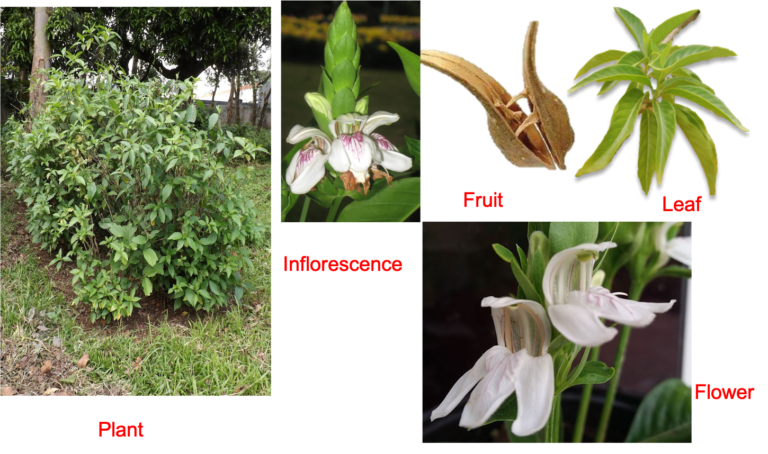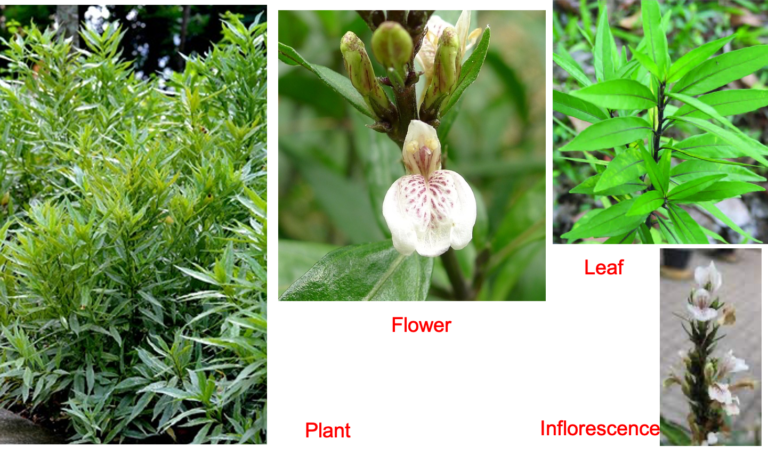VASA
Vasa a plant that has been mentioned in Charaka Samhita as the best one to treat the disease Raktapitta (Bleeding disorder or Plethora) but is found through various research studies that it is a very good bronchodilator. The plant is a very important one in Ayurveda as there are many prominent formulations that are being used even today. The species that is being accepted as Vasa officially is Adathoda vasica Nees belonging to the family Acanthaceae. Another species namely Justicia gendurussa Linn., also belonging to the same family is considered as a variety of Vasa known as Krishna Vasa. The plant is commonly seen as a hedge plant all over India upto an elevation of 4000 feet. The word Adathoda is derived from malabar name “Adolakam” while the word vasica is derived from the sanskrit word “vasak” which means aromatic.
PLANT DETAILS
BOTANICAL NAME
Adathoda vasica Nees.
Justicia gendurussa Linn
FAMILY
Acanthaceae
NOMENCLATURE
VERNACULAR NAMES
- Kannada – Adusoge
- Malayalam – Adolakam
- Tamil – Evadad
- Telugu – Adasara
- Hindi – Arhusa
- English – Malabar Nut
SANSKRIT SYNONYMS
- वासा (Vasa), वासक (Vasaka) – The plant that grows in plenty with dense foliage
- अटरूष (Atarusha) – The herb is a useful drug to cure many diseases.
- सिंहिका (Simhika) सिंहास्य (Simhasya) – The flower looks like the mouth of the lion
- भिषङ्गमाता (Bhishangmata) – A very useful plant for medicinal purposes and protects physician like mother.
- वाजीदन्त (Vajidanta) – The flower resembles with the horse teeth.
SAMHITA CLASSIFICATION
- Charaka Samhita – None
- Sushruta Samhita – None
NIGHANTU CLASSIFICATION
- Dhanvantari Nighantu – Guduchyadi Varga
- Bhavaprakasha Nighantu – Guduchyadi Varga
- Raja Nighantu – Shatahvadi Varga
- Kaiyadeva Nighantu – Aushadhi Varga
BRIEF MORPHOLOGY
VASA – Adathoda vasica Nees. –
A diffuse foetid shrubs with short internodes. Leaves are ovate or elliptic-lanceolate, acuminate, simple, sessile or sub-sessile. Inflorescence is terminal spikes at the branch ends with white flowers with pink or purple streaks. Fruits are capsule, clavate, pubescent with sub-orbicular seeds.
KRISHNA VASA – Justicia gendarussa Linn –
A undershrub with terate, glabrous dark purple twigs. Leaves simple, linear-lanceolate, glabrous on both sides, entire. Inflorescence is terminal or axillary spikes or panicled spikes with subsessile flowers that are white in colour with purple streaks and spots inside. Fruits are capsule, glabrous with 4 seeds.
PHARMACOGNOSY OF OFFICIAL PART
MACROSCOPY
YET TO BE COMPILED
MICROSCOPY
YET TO BE COMPILED
PART USED AND POSOLOGY
PART USED
मूल (root), पत्र (leaves) and पुष्प (Flowers)
DOSE
मूल क्वाथ (Root Decoction) – 40 to 80ml पत्र स्वरस (Leaf juice) – 10 to 20ml, पुष्प स्वरस (Flower juice) – 10 to 20ml
PHYTOCHEMISTRY
VASA – Adathoda vasica Nees. –
The plant contains phenols, tannins, saponins, alkaloids, anthraquinones, flavanoids and reducing sugars. It also contains essential oils, fats, resins, sugar, gum, amino acids, proteins and Vitamin C. The most prominent phytochemical is vasicine a bitter alkaloid found in the leaves, roots and flowers. This component shows a bronchodilator action. Other than this there is also presence of vasicinone, vasicinol, adhatodine, adhatonine, adhvasione, anistone, etc alkaloids, betaine, steroids and alkanes.
KRISHNA VASA – Justicia gendarussa Linn –
The roots contain alkaloid, steroid, flavanoid, phenol, carbohydrate, saponin, triterpenoids, 2-amino benzyl alcohol, β-sitosterol-β-D-glycoside, gendarusin A, gendarusin B, lupeol and quinone.
रसपञ्चक कर्म PROPERTIES AND USES AS PER AYURVEDA
गुण (Properties)
- रस (Rasa) – तिक्त (Tikta), कषाय (Kashaya)
- गुण (Guna) – रूक्ष (Ruksha), लघु (Laghu)
- वीर्य (Veerya) – शीत (Sheeta)
- विपाक (Vipaka) – कटु (Katu)
- प्रभाव – None
कर्म & प्रयोग (Action & Indications)
- दोषकर्म (Doshakarma) – कफपित्तमक (Kaphapittashamaka)
- धातुकर्म & मलकर्म (Dhatukarma and Malakarma) – Main actions – स्वर्य, श्वासहर, कासहर, ज्वरघ्न, रुच्य, कुष्ठघ्न, प्रमेहघ्न & हृद्य (Swarya, Shwasahara, Kasahara, Jwaraghna, Ruchya, Kushtaghna, Pramehaghna & Hridya)
- Other Actions – छेदन, रक्तशोधक, स्थम्भन, अर्शोघ्न, स्वेदजनन, मूत्रजनन, रसायन &मेदोहर (Chedana, Rakstashodhaka, Sthambhana, Arshoghna, Swedajanana, Mutrajanan, Rasayana & Medohara)
- प्रयोग (Prayoga) – Mainly रक्तपित्त, श्वास, कास, ज्वर, प्रमेह, अरुचि, छर्दि, कुष्ठ, तृष्ण & क्षतक्षय (Raktapitta, Shwasa, Kasa, Jwara, Prameha, Aruchi, Chardi, Kushta, Trishna & Kshatakshaya), also useful in अतिसार, मूत्रदाह, प्रवाहिक, आमवात, अपतन्त्रक, अपस्मार, व्रणशोथ & नाडीशूल (Atisara, Mutradaha, Pravahika, Amavata, Apatantraka, Apasmara, Vranashotha & Nadishula)
AYURVEDIC FORMULATIONS
CLASSICAL
- वासावलेह
- वासकासव
- वासकारिष्ट
- वासाघृत
- पञ्चतिक्तघृत
- महापञ्चतिक्तघृत
PROPRIETARY
- Vasa Syrup
- Vasaka
- Vasa capsule
AGRONOMY
ENVIRONMENT
The plant grows in variety of environmental conditions out of which the most preferred one is the alluvial soil. It is tolerant to shade but susceptible for water logging. It prefers a lowland tropical environment with temperatures between 20-27 deg C with an annual rainfall of 700 to 1700mm.
CULTIVATION
The plant is effectively propagated through stem cuttings with 4-5 internodes are planted on the ridges or mounds. It is planted just before the rainy season with a spacing of 30cm from each other on ridges. Water logging is to be avoided and irrigation is preferred once in every 4 days. If nursery planting is done, then the time is preferred between March and April so as have rooted cuttings for the purpose of planting. Around 1000 stem cuttings can be planted in acre.
HARVESTING
Among the parts of the plant, leaves, roots and stem are used for various medicinal purposes. Leaves can be harvested from the 1st year of planting but roots are only after the completion of the 2nd year. The roots are harvested, cleaned and are either dried or sold in wet form itself. The average total yield of leaves, stem and root is 4 to 4.5 tonnes per acre.
STORAGE
The harvested plant is sold in either wet form or are dried and marketed. The roots thus harvested are cleaned from any soil that has come while procuring it without damaging the roots. Then they are stored in a general manner after drying.
VARIETIES AND SUBSTITUTES OR ADULTERANTS
VARIETIES
Practically there are two varieties that are in vogue namely Adathoda vasica Nees and Justicia gendarussa Linn which are known as Vasa and Krishna vasa respectively.
ADULTERANTS
NO KNOWN ADULTERANTS
SUBSTITUTES
Adathoda beddomei Clarke is also reported to be used in the state of Kerala as Vasa.
TOXICITY
TOXIC SYMPTOMS
- The plant is regarded as non-toxic
ANTIDOTE
- Not necessary
शोधन or PURIFICATION METHOD
- NOT NECESSARY
THERAPEUTIC USES
- The leaves are applied on the affected part to treat conditions like Rheumatic arthritis, Neuralgia and even skin diseases.
- An oil prepared from the plant is used for massage in the treatment of tetanus, epilepsy, rheumatic disorders, etc.
- A decoction prepared from 50g roots of Krishnavasa is boiled with ginger and lime, is given internally to treat Rheumatic arthritis.
- The leaves, stem and roots are given internally in the form of fresh juice or decoction to treat urinary complaints, diabetes and other urinary related disorders.
- Decoction of roots is given to treat urticaria and other skin diseases.
CONTROVERSY (IF PRESENT)
YET TO BE COMPILED
LIST OF RESEARCH STUDIES
- Sharma, Ajay, Garima Bhardwaj, and Damanjit Singh Cannoo. “Overview of Phytochemistry and Pharmacology of Adhatoda vasica.” health care 7.8 (2018): 9.
- Kharel, Rakesh. “Indian traditional herbs Adhatoda vasica and its medicinal application.” J. Chem 2.1 (2010): 240-5.
- Yadav, Deepa et al. “Botanical and Chemical Fingerprinting of Medicinal Roots of Justicia gendarussa Burm f.” Pharmacognosy research vol. 9,2 (2017): 208-214. doi:10.4103/0974-8490.204643




